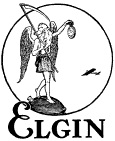Know Your Product

Know Your Product |

|
|
|
Part 1, The Screw Department, The Watch Word, October 1935Lloyd P. DooleyEditor's Note - This is the first of a series of articles on the manufacture of a watch as conducted in the factory of The Elgin National Watch Company. It is our hope to acquaint our readers with the work of departments other than their own. |
|
||
|
It is particularly fitting that a series of articles on the manufacture of a watch should begin with a discussion at the work of the Plate department, for the plates form the foundation and iramework of the watch. Five plates are used in every watchthe pillar, or lower plate, which supplies the lower bearings for the train and escapement and which is the foundation upon which the watch is built; the barrel bridge. which covers the mainspring barrel and supports most of the stem work; the train bridge, which supplies the upper bearing for the train; the balance bridge which holds the jewels for the upper balance staff pivots, and the pallet bridge, which supplies the upper bearing for the pallet arbor. In brief, the work of the Plate department consists of surfacing, or cutting all plates to the desired thickness; profiling, or smoothing the edges of the plates; recessing, or cutting away the plates to make clearances for the various wheels in the mechanism of the watch; drilling, tapping and counter-sinking the holes for the different screws and steady pins; setting the jewels, gauging the jewel holes and installing the jewels in the plates. Plate blanks are purchased in the rough in the approximate shapes in which they are to be used. The first operation is that of facing or surfacing the plate to the proper thickness. The machines that do this work are very sensitive and accurate to a ten-thousandth of an inch. The work is gauged on dial gauges, which can measure down to .0001 of an inch. |
|
|||
|
One of the most important operations is that of punching the three work holes in the lower, or pillar plates. This is important because all other work done on the plates is located from these three holes. Every chuck and jig has steady pins which fit into these holes and hold the plates in exactly the proper position while the various opperations are performed. These same holes are also used to hold the dial feet on the finished watch. The screw and dowel pin holes are drilled in the plates by a machine capable of drilling fifty holes per minute. The operator places the work in the machine and removes it when completed. The machine automatically selects the position and drill size and if the drill breaks, or does not reach the proper depth, the machine automatically stops. The recesses, or clearances for the watch train, are also cut by a machine which selects the position, diameter and depth with no direction from the operator. All recesses are cut in one continuous operation and the chips are carried away by vacuum. The small bridges are shaped and trimmed by dies in a punch press and the engraving is diestamped. After the various facing, drilling, recessing and press operations, the pieces are numbered; one pillar plate, barrel bridge, train bridge, balance bridge and pallet bridge having the same serial number. The holes for the lower jewels are bored on a quill chuck which is accurate to .001 of an inch, and each hole is bored on an individual quill for that particular center. The screw holes are threaded one at a time, on a geared tapping machine which is so constructed that it cannot overfeed and strip the threads. The jewels, which have already been fitted into the wheels that are each assigned to a certain watch, are now burnished into the proper hole in the plate. Dowel pins are then screwed into the bridges. These pins are made from wire and screwed in at one operation, being shaved to size and position. The bridges are fitted to the pillar plate by corresponding number, and while being held to position by the dowel pins, they are screwed down with service screws. The assembly is then turned to fit the case and the correct diameters and elevations are produced in one operation. The holes for the upper jewels are bored on a quill similar to the one used to bore the lower and the same locating holes are used. In a seven jewel watch the upper pivot holes for the train wheels are drilled with a drill which is often as small as .004 of an inch in diameter. To locate these upper train centers from the same locating holes, and to assure them being in exact line with the lower centers, is the reason for numbering and fitting the bridges to the pillar plates. After the bridges are removed from the pillar plate, the upper jewels that are assigned to the watch are fitted into holes bored in the bridges. The upper jewels are held in position by two small screws and the holes for these screws are threaded after the jewels are in position. The drilling operations produce sharp, uneven edges and to overcome this the holes are countersunk or chamfered. Recessing, milling, and turning produce burrs which are cut away by hand. Inspection at various stages of manufacture and of the finished work is visual. Measuring and gauging is to .0001 of an inch, and after passing strict standards of inspection, the pieces are matched by number and the complete assemblies delivered to the Gilding department. In an early issue we will describe the work of that department. |
||||
|
||||
|
|
||||

|
|
|||
|
|
||||
Comments to jsexton@elgintime.com